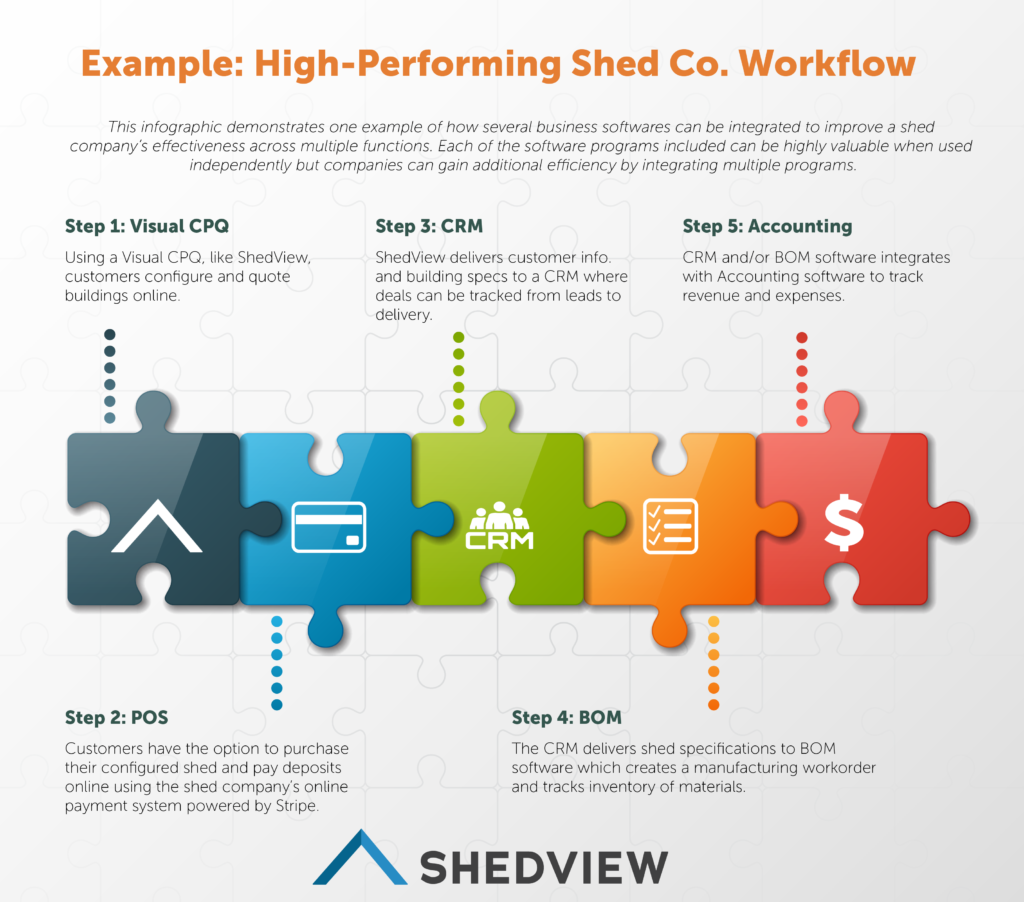Sorting through the many varieties of business software can be daunting and confusing. What is the difference between a CRM and CPQ? Which programs are relevant to my business? What would I use them for? This guide provides a quick reference to several types of business programs and how they might be useful for a shed company.
- CPQ (stands for “Configure, Price, Quote”)
- Definition: Technology that allows companies to create accurate sales quotes by configuring the customer’s desired product, calculating the price of the configured product, and generating a quote to provide to the customer.
- Examples: Apttus, QuoteWerks
- Useful for shed companies? Yes. CPQ software is extremely valuable for quoting custom products like sheds. This software can be used behind the scenes by your sales team or integrated into your website, allowing your customers to generate instant quotes online. Instant online quoting is increasingly important to consumers who are being trained to expect a robust online shopping experience.
- Visual CPQ
- Definition: CPQ that uses 3D digital animation to allow sales reps and customers to configure their products using the 3D model.
- Examples: ShedView, 3DFish, Configit
- Useful for shed companies? Yes. Visual CPQ transform the quoting process from a specialized process requiring an expert understanding of terminology to a fun, intuitive, creative process. Making a visual CPQ available to your customers allows them to easily understand the product options and see the product they are purchasing. The output of the Visual CPQ includes both an image of the final product and an itemized list of components and prices.
- CRM (stands for “Customer Relationship Management”)
- Definition: Technology for managing the company’s relationships and interactions with customers and potential customers.
- Examples: Hubspot, Salesforce, Zoho, Pipedrive
- Useful for shed companies? Yes. CRM’s are usually highly configurable, which means that each company can customize many aspects the program to fit your needs. There are also many highly affordable CRM options (Hubspot offers a free version) and lots of professionals who can help you configure your CRM if you need assistance. Your sales and customer service teams will benefit from a centralized source of customer information. Here are just a few examples of how a CRM can be used by a shed company:
- Connect your CRM to your online forms or visual configurator so every customer inquiry is instantly and automatically entered into your CRM.
- Easily run reports of critical data like the number of sales made and in-progress for any period.
- Schedule reminders to follow-up with potential customers.
- ERP (stands for “Enterprise Resource Planning”)
- Definition: Technology that integrates systems across many departments of an organization to automate functions and allow reporting.
- Examples: Epicor, Oracle, SAP
- Useful for shed companies? Generally, no. Most shed companies’ operations do not require an ERP system. ERP systems are generally most beneficial for very large, complex companies. The software often takes months to implement and is very expensive.
- BOM (stands for “Bill of Materials”)
- Definition: Technology that creates a list of the raw materials, sub-assemblies, intermediate assemblies, sub-components, parts, and the quantities of each needed to manufacture an end product.
- Examples: Fishbowl, OpenBom, NetSuite
- Useful for shed companies? Maybe. Depending on the size of their operation and their cash flow management strategy, shed manufacturers may gain significant efficiency and accuracy improvements from switching manual processes to a BOM. Especially considering inexpensive and free options like Fishbowl and OpenBom. Integrating your BOM to your Visual or standard CPQ can further increase efficiency by removing double-entry.
- POS or POP (stands for “Point of Sale or Point of Purchase”)
- Definition: Software that completes a purchase.
- Examples: Stripe, PayPal, Shopify, WooCommerce, Braintree
- Useful for shed companies? Maybe. For shed companies wanting to collect payments online, this software is necessary. POS software is the modern-day cash register and there are a variety of categories. Here are two examples:
- Shopping cart software like Shopify and WooCommerce are simple shopping applications that allow customers to buy defined products. Shopping carts are great when your product has limited variations (e.g., clothes). For custom shed companies, shopping cart software likely won’t handle the multitudes of possible shed configurations you offer.
- Online payment software simply allows companies to receive payment over the internet or with mobile devices. Coupled with a CPQ, online payment software can allow your website to be your point of sale. For example, your customers could use ShedView to configure a building and then check out and pay online using Stripe.

